Abstract
This project seeks to broaden conceptions, understandings, and applications of food justice through applying food justice to the private food assistance network. The private food assistance network consists of food banks, food pantries, and other meal programs that seek to provide food to food insecure people through an alternative food system that has thus far been understudied by food justice scholarship. I incorporate a food justice perspective into the study of food banks to better understand how certain communities may have better access to this alternative food system than others.
While an already sizable portion of the population relies on private food assistance, food bank usage has increased during the COVID-19 pandemic and associated economic crisis. Little is known about how food banks vary by location or affiliation. I examine how the locations and resources of food banks impact the availability and equitability of access to food assistance in California. I use regression analysis to examine the spatial accessibility of food banks in relationship to poverty, race, and rurality in California. Through preliminary analysis, I find that poverty and race have significant associations with food bank accessibility, which are moderated by urbanicity.
These findings have important implications for reliance on food banks to distribute food assistance. Based on these results, reliance on this network or organizations as they currently exist may be further exacerbating existing inequities in food access.
